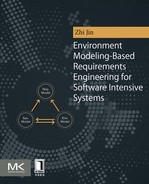Table of Contents
Chapter 1. Requirements and Requirements Engineering
1.3. Three Dimensions of Requirements Engineering
Chapter 2. Requirements Engineering Methodologies
2.1. Metaphor: “To-Be System Is for Automatically Measuring and Controlling the Reality”
2.2. Metaphor: “To-Be System Is for Fulfilling Real-World Goals That Stakeholders Want to Achieve”
2.3. Metaphor: “To-Be System Is for Improving the Dependencies Among Intentional Actors”
2.4. Metaphor: “To-Be System Is for Enhancing the As-Is System Usage Experience”
2.5. Metaphor: “To-Be System Is for Establishing Relationships Among Phenomena of Reality”
Chapter 3. Importance of Interactive Environment
3.1. Software-Intensive Systems
3.2. Challenges to Requirements Engineering
Part 2. Ontology and System-Interactive Environment Ontology
Chapter 4. Ontology-Oriented Interactive Environment Modeling
4.3. Ontology-Oriented Domain Modeling
4.4. Top-Level Environment Ontology
4.5. Domain Environment Ontology
Chapter 5. Domain Environment Ontology Construction
5.1. Domain Environment Modeling via Knowledge Engineering
5.2. Domain Environment Ontology Construction
5.3. Automatic Domain Environment Ontology Construction
5.4. Another Example of Domain Environment Ontology
Chapter 6. Feature Model of Domain Environment
6.1. Feature Model and Feature Configuration
Part 3. Environment Modeling-Based System Capability
Chapter 7. Effect-Oriented System Capability
7.1. Capability Specification of Semantic Web Services
7.2. Effect-Based Capability Model
7.3. System Capability Profile
Chapter 8. Reasoning I: System Capability Comparison and Composition
8.1. Related Work in Service-Oriented Computing
8.2. Environment Modeling-Based Capability Comparison
8.3. Environment Modeling-Based Capability Composition
Chapter 9. Reasoning II: System Capability Refinement
9.1. Guided Process for Scenario Description
9.2. Scenario-Based Capability Projection
Chapter 10. Reasoning III: System Capability Aggregation
10.1. Principles and Architecture
10.2. Requirements-Driven Agent Aggregation
Part 4. Environment-Related Nonfunctionalities
Chapter 11. The System Dependability Problem
11.1. Background and Principles
11.2. Cybernetics and Model of Dependable Systems
11.3. Function and Control Capability Profile Cluster Requirements Elicitation and Modeling
Chapter 12. The System Dynamic Adaptability Concern
12.1. Dynamic Adaptation Mechanisms
12.2. Modeling Dynamic Adaptation Capability
12.3. Expression of Conformance-Based Dynamical Adaptation
Chapter 13. Other Nonfunctionality Patterns
13.2. Problem-Oriented Nonfunctional Requirement Patterns and Their Concerns
